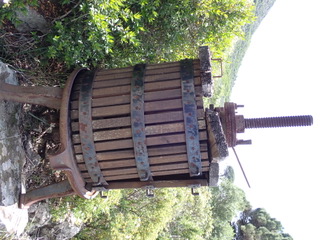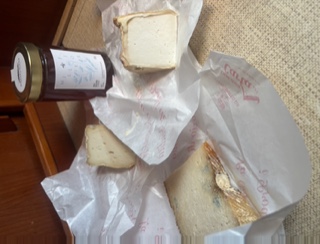43:03.035N 009:50.416E

Muskrat
Chris and Alison
Mon 12 May 2025 19:28
With the wind forecast improved and hopefully, a working engine, we decided to leave for Isola Di Capraia. Up again at 0500 and donned thermals and foulies, it was still cold and damp. This time we had the emergency fuel system ready to go and we were also ready in case we found an enormous cruise ship coming into the bay as we left. The windlass worked and the anchor came up. We motored out of the anchorage and put the sails up. No cruise ship in sight so we headed straight out passed the breakwater and off on our way. Apart from a fishing vessel nearly running us down while he overtook us, there was no other encounters with shipping this time. There was a horrid swell with breaking waves on the tops left over from the strong southerlies we had been having, but we stuck with it and ploughed our way through. It wasn’t long before we could sail and make a reasonable 5-6knts in a F4-5, despite the swell. The autopilot that had refused to work up to now, suddenly started to work, so we left it switched on and monitored it all the way to Capraia. It continued to work for the entire trip. All was going well with the passage until I thought I heard the coastguard calling a sailing vessel. I looked around and we were the only sailing vessel I could see. We were passing Isola Di Gorgona at the time, so I thought they might be calling another yacht the other side of the island. But they persisted in calling a sailing yacht. We had our AIS on and it was transmitting, so our ships name should come up on their screens but they were not using a name of a vessel. After a while I suddenly realised that we had strayed into a zone 1 area, that is an area where navigation is prohibited as it is a Tuscan Archipelago National Park. We tacked quickly to exit area and no more was heard from the coastguard. Lesson learnt, check the restricted areas carefully on the chart plotter, they are not easy to see on the screen, but they are marked very clearly in the pilot book. My mistake, as I had done the passage plan. On the way, Chris tried the water maker and made some super fresh drinking water out of sea water. We have a working water maker at last. We arrived in Isola Di Capraia at 1830, 12 hours 10 minuets after leaving, we had travelled 77nm due to the diversion getting out of the restricted area. We anchored just outside the harbour in 13m of water and had a beer. Capraia was once a penal colony, so the over-tourism, suffered on many other Italian islands, hasn’t happened here, thanks to the strict regulations on car use and protected national park status, that isn’t likely to change. Since the last prisoners left in 1986, the land has been returned to the islanders and it has had a agritourism revolution. Reviving the old traditions of organic goats cheese making (the island takes its name from the goats who still roam the craggy hills), millennia old winemaking techniques using terracotta amphfore, anchovie fishing and honey production, all with the aim of creating jobs for the next generation of islanders and giving them a reason to stay. The island is very steep and rocky, covered with maquis, myrtle, olive trees, oleander and herbs. It is not cultivated except for the terraced slopes of vineyards on the coast. The produce is organic due to the lack of agricultural farming and pollution. In the end, we stayed 3 nights, walking in the hills with the aroma of the herbs, flowers and trees in the air. The trails are very well marked but did get quite difficult at times climbing over rocks and slipping through fords. There is only one road on the island, so walking away from everything is very easy and very quickly the silence is deafening. We both thought Capraia was well worth a visit, but we could see that in the summer, it probably gets very busy with yachts in the bay and tourists using the daily ferry from the mainland, so May was probably the best time of year to see this beautiful island. We stocked up on the islands produce of goat’s cheese and honey, but didn’t sample the wine. Our stress levels further reduced when the outboard on the dinghy started to behave, so our trips in and out of the harbour were much easier and quicker.  Muskie anchored outside the harbour at Isola di Capraia  Oleandro grows on Capraia. It is the most northerly place it grows as it is native to Africa.  One of our walks in the Botanical nature reserve.  Blissful quiet walking in the countryside.  Still plenty of water running off the mountains on our walk.  The lake filling the volcanic cauldron.  Ancient wine press  More recent wine press.  Local goats cheeses and Honey |